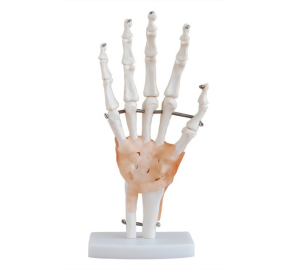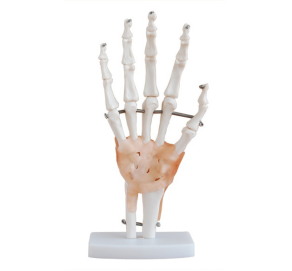ADA MED SUPPLY LIMITED
Phone:+86 19937901373
Tel:+86-0379-65160607
Email:adaanatomy@adaanatomy.com


The hand joint band ligament model uses a variety of designs and mechanisms in simulating ligament function to ensure that students can intuitively understand the important role of ligaments in hand joint movement. Here is a detailed explanation of how the hand band ligament model simulates ligament function:

Material and structure selection:
Hand joint band ligament models are usually made of durable and elastic materials to simulate the physical properties of real ligaments. These materials can simulate the elasticity and strength of ligaments, allowing students to feel the tension and limiting role of ligaments in joint movement during manipulation.
Geometric simulation of ligaments:
The model accurately simulates the shape and position of the ligaments. For example, the collateral ligaments (ulnar and radial) are placed precisely on either side of the knuckles of the hand to demonstrate their limiting role in joint movement. In addition, the palmar ligaments are simulated to demonstrate the support and stability of the hand joint.
Simulation of joint movement:
Models are usually designed to be movable, allowing students to simulate flexion and extension of finger joints. During this process, students can observe how the ligaments change with the movement of the joint. For example, when the joint is extended, the collateral ligament is in a relaxed state; When the joint flexes, the collateral ligaments are strained to limit the lateral movement of the joint.
Simulation of mechanical properties:
The model simulates the mechanical properties of the ligament as closely as possible, such as the elastic modulus and maximum stress. These mechanical properties determine how ligaments respond to joint motion. By simulating these properties, students gain a deeper understanding of the role and mechanisms of ligaments in joint movement.
Teaching interaction:
In addition to the above simulation functions, the hand joint band ligament model can also be used for teaching interaction. Teachers can use the model for demonstration and explanation to help students better understand the anatomy and function of ligaments. Students can also do hands-on work to deepen their understanding of ligament function by manipulating models.
Comprehensive simulation:
Some advanced models of hand ligaments can also simulate the interactions between multiple ligaments and their collaboration with other structures such as articular cartilage and capsular joints. This integrated simulation is able to provide a more comprehensive teaching experience and help students more fully understand the complex structure and function of hand joints.
In summary, the hand joint belt ligament model effectively simulates the function of ligaments in hand joint motion through various methods such as accurate material selection, geometric simulation, joint motion simulation, mechanical properties simulation and teaching interaction, providing strong support for medical teaching.